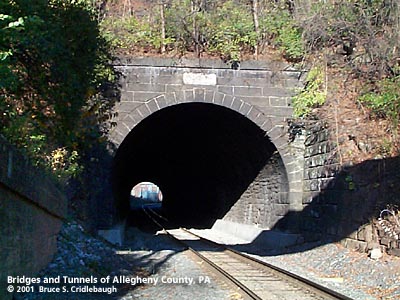| Home > All By Location regional map > Braddock > Port Perry Tunnel | |||
|
|

Southern portal near Monongahela River More detail photos OFFICIAL NAME: OTHER DESIGNATION: Port Perry Tunnel LOCATION: North Versailles USGS 7.5" Topo Quad - UTM Coordinates: Braddock - Zone 17; 0597 4471 CARRIES: Norfolk Southern RR [Pennsylvania RR, Conrail] BETWEEN: -- Bessemer Junction, Brinton Station -- Port Perry Bridge over Monongahela River UNDER: Miller's Hill (aka Delightful Hill) TYPE OF CONSTRUCTION / DESIGN: semi-circular horseshoe profile bored through rock stone portals brick ring interior TOTAL LENGTH: 514 ft OTHER DIMENSIONS: 24.5 ft est wide at base 26 ft est wide at spring line 19.5 ft est from top of rail to top of arch rise YEAR OPENED / ENGINEER: 1877; assistant engineer/superintendent, Charles W. Schwab ADDITIONAL INFO: The Port Perry Tunnel serves the Port Perry Branch connection from Pennsylvania Railroad at Brinton (Bessemer Junction) on Turtle Creek to Pittsburgh, Virginia & Charleston Railway (later PRR Monongahela Division) on left descending bank of Monongahela River at Duquesne. All of these lines are now part of the Conrail properties acquired by the Norfolk Southern in 1989. Hopkins maps show the tunnel as double-tracked in 1900. Historic American Engineering Record reports the bridge across the Monongahela River as having been double-tracked. Both are now single-track. A builder stone above the southern portal is illegible. Assistant engineer/superintendent for the Port Perry tunnel construction was Charles W. Schwab. He was an engineer and draftsman for Carnegie, McCandless & Company which began construction on its Edgar Thomson Works in 1872, five years before the tunnel. Mr. Schwab was General Superintendent of the Edgar Thomson Works in 1889 and was put in charge of the Homestead Works after the Homestead riots. The Carnegie Steel Company became part of United States Steel in 1903. (John) J. Edgar Thomson was the third president of the Pennsylvania Railroad. In 1857, he combined the Erie Railroad's divisional structure with the Baltimore & Ohio's departmental structure and decentralized the growing Pennsylvania Railroad into operational divisions. Andrew Carnegie and his partners built the steel works at the outflow of Turtle Creek into the Monongahela River, between Port Perry and Braddock's Field, to supply the Pennsylvania Railroad with steel rails. In honor of his former employer and probably as an enticement to win the rail contract, Carnegie named the steel work for Mr. Thomson. In 1897, Carnegie completed the Bessemer & Lake Erie Railroad to supply the steel works with the raw materials for steelmaking -- finding it more suitable to control rail tansportation costs by building his own railroad rather than negotiate further with the PRR with which he got his start. The southern end of the line was at the east end of the Edgar Thomson Works where the former town of Brinton was renamed Bessemer. All aspects of the steelmaking process were brought together under the United States Steel Corporation from mining to finishing. Sites along the Monongahela River covered the entire process. Today, the Edgar Thomson Works is one of the few steelmaking operations remaining in the Monongahela Valley. Two blast furnaces are still in operation -- combining iron ore taconite pellets delivered via the B&LE RR and Union RR with coke from the Clairton Coke Works and limestone/dolomite -- to make steel slabs. The slabs are transported by the Union RR to the Irvin Works in West Mifflin for rolling and stamping into sheet products. The town of Port Perry has been completely obliterated by the crossing and recrossing of railroads there. Today the Norfolk Southern, CSX [B&O] and the Union Railroad fill every usable bit of ground where a town of over 3,000 people once stood. view page - More history of the town of Port Perry view page - More history of the Edgar Thomson Works view page - Port Perry Bridge over Monongahela River FIELD CHECKED: INFO SOURCES: Hopkins plat maps; Lamb, ed., "The Unwritten History of Braddock's Field," 1917 Submit info or inquiry - share some facts or ask a question. Introduction -- Nearby Structures Page created: Last modified: 12-Nov-2001 |
View Larger Map 
| |
| copyright: © Bruce S. Cridlebaugh 1999-2008 All Rights Reserved | |||